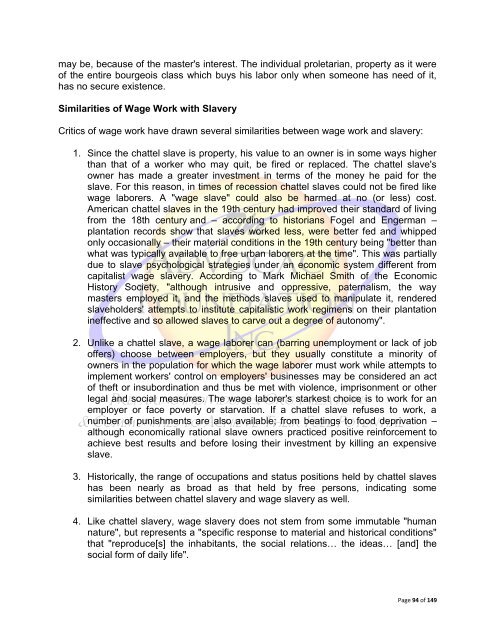Hidden Unemployment
Hidden Unemployment
Hidden Unemployment
You also want an ePaper? Increase the reach of your titles
YUMPU automatically turns print PDFs into web optimized ePapers that Google loves.
may be, because of the master's interest. The individual proletarian, property as it were<br />
of the entire bourgeois class which buys his labor only when someone has need of it,<br />
has no secure existence.<br />
Similarities of Wage Work with Slavery<br />
Critics of wage work have drawn several similarities between wage work and slavery:<br />
1. Since the chattel slave is property, his value to an owner is in some ways higher<br />
than that of a worker who may quit, be fired or replaced. The chattel slave's<br />
owner has made a greater investment in terms of the money he paid for the<br />
slave. For this reason, in times of recession chattel slaves could not be fired like<br />
wage laborers. A "wage slave" could also be harmed at no (or less) cost.<br />
American chattel slaves in the 19th century had improved their standard of living<br />
from the 18th century and – according to historians Fogel and Engerman –<br />
plantation records show that slaves worked less, were better fed and whipped<br />
only occasionally – their material conditions in the 19th century being "better than<br />
what was typically available to free urban laborers at the time". This was partially<br />
due to slave psychological strategies under an economic system different from<br />
capitalist wage slavery. According to Mark Michael Smith of the Economic<br />
History Society, "although intrusive and oppressive, paternalism, the way<br />
masters employed it, and the methods slaves used to manipulate it, rendered<br />
slaveholders' attempts to institute capitalistic work regimens on their plantation<br />
ineffective and so allowed slaves to carve out a degree of autonomy".<br />
2. Unlike a chattel slave, a wage laborer can (barring unemployment or lack of job<br />
offers) choose between employers, but they usually constitute a minority of<br />
owners in the population for which the wage laborer must work while attempts to<br />
implement workers' control on employers' businesses may be considered an act<br />
of theft or insubordination and thus be met with violence, imprisonment or other<br />
legal and social measures. The wage laborer's starkest choice is to work for an<br />
employer or face poverty or starvation. If a chattel slave refuses to work, a<br />
number of punishments are also available; from beatings to food deprivation –<br />
although economically rational slave owners practiced positive reinforcement to<br />
achieve best results and before losing their investment by killing an expensive<br />
slave.<br />
3. Historically, the range of occupations and status positions held by chattel slaves<br />
has been nearly as broad as that held by free persons, indicating some<br />
similarities between chattel slavery and wage slavery as well.<br />
4. Like chattel slavery, wage slavery does not stem from some immutable "human<br />
nature", but represents a "specific response to material and historical conditions"<br />
that "reproduce[s] the inhabitants, the social relations… the ideas… [and] the<br />
social form of daily life".<br />
Page 94 of 149

















